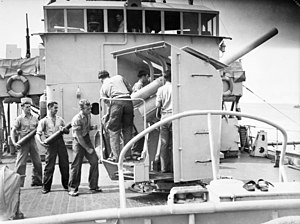|
QF 4-inch naval gun Mk XIX
The QF 4-inch Mk XIX gun[note 1] was a British low-velocity 4-inch 40-calibre naval gun used to arm small warships such as Bathurst and Castle-class corvette and some River-class frigate in World War II, mainly against submarines.[3] DescriptionIt succeeded the higher-velocity World War I-era BL 4-inch Mk IX (typically deployed on Flower-class corvettes in the escort role). The Mk XIX fired fixed ammunition which was 38.5 inches (0.98 m) long and weighed 50 pounds (23 kg).[3] The weight of the projectile was increased from 31 pounds (14 kg) for the Mk IX to 35 pounds (16 kg) for the Mk XIX. The high-angle mounting used for the XIX added some anti-aircraft capability and allowed it to fire starshells to illuminate the battle area at night.[2] Ammunition
Surviving examples
Notes
References
Bibliography
External linksWikimedia Commons has media related to QF 4 inch Mk XIX naval gun.
|
||||||||||||||||||||||||||||||||||||||||


